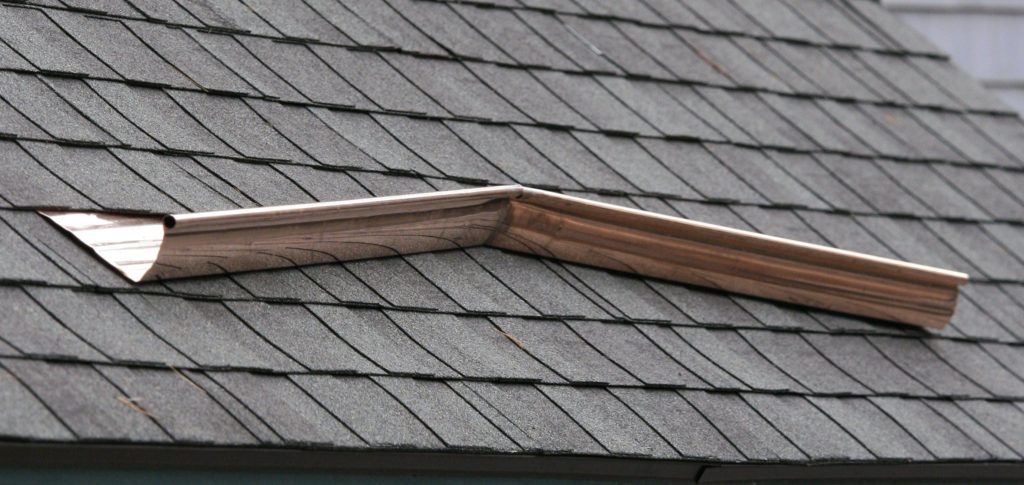Rain gutters are instrumental in draining water away from your house. During heavy rains, they keep the walls of your dry and cut down splashback onto your siding.
Despite the usefulness of gutters, they do have certain limitations. Roofing contractors may be unable to install these roofing products due to aesthetic or functional issues. Whatever the case may be, these professionals will need to install a different product to effectively redirect rainwater away from your roof.
Enter the rain diverter, your alternative to the traditional rain gutter.
What is a Rain Diverter?

A roof rain diverter is an inconspicuous strip of metal slipped beneath the roofing to channel water sideways. These rain gutter diverters typically come in an L- or J-shaped pattern. You could, however, choose other diverter styles to suit the needs of your roof along with your existing roofline drainage system.
A rainwater diverter works by channeling water onto a downpipe. The rainwater then travels from the roofline all the way to the ground (or a water storage tank if your home has one).
Differentiating Rain and Downspout Diverters
Some homeowners tend to confuse the roof rain diverter and a downspout diverter, also known as a rain barrel diverter. The purpose of a downspout diverter is to prevent the collected rainwater in the barrels from spilling onto your pavement. Once the barrel fills up, the excess rainwater travels through a hose and right back to the downspout. If the rain barrel diverter has additional ports, it could redirect the overflow to a second barrel.
Long story short, rain diverters serve as a stand-in for your roofing gutters. Rain barrel diverters, on the other hand, give extra runoff protection for your home.
What are the Benefits of a Rain Diverter?

A roof water diverter is an aesthetic necessity with many advantages. This product helps save you money on water bills. Rather than get water from your tap, you could collect and use rainwater for various household purposes (learn more on this in our bonus guide section).
A rain gutter diverter also helps reduce ground saturation. During heavy rainfall, the gutter system will quickly channel all the rainwater to your drainage system. This, however, may lead to overflowing. The excess water could cause the ground to become saturated. It could also leave behind an unsightly and muddy garden soil.
Having this piece of equipment on your roof minimizes the amount of water traveling into the ground drainage system of your house by channeling the water to a rain barrel. A rain diverter is an excellent way to protect your property during heavy rains.
How to Install a Rain Diverter on Your Roof

You have two options for installing a rainwater diverter: hire an experienced and trustworthy general contractor or take on this job yourself. If you want to take a DIY approach to this home improvement project, keep these installation steps in mind:
- Purchase a rain diverter at your nearest building supply store. If they don’t have this product available on their shelves, you could create one from sheet metal yourself (see our next section for more details).
- Once you have the rain gutter diverter you need, climb a sturdy ladder to your roof and find the second row of shingles near the edge of the roof.
- Use a pry bar to loosen up the shingles on your roof. Caution: Exercise care when performing this task, as you’re not supposed to tear or rip your shingles. If you encounter stubborn shingles, force them up by tapping the butt of the pry bar using a rubber mallet.
- Place the long side of the roof rain diverter beneath the shingles. Make sure that you leave the end of the diverter hanging out. Then, position the diverter properly by centering it over the entry area.
- Use nails to firmly secure the diverter into place. Then, cover them with liquid cement to prevent leakage.
- Push down the shingles and hold them firmly for approximately ten seconds to form a solid bond.
How to Make a Rain Diverter

If the rain gutter diverters you want are out of stock, you could make a customized product using sheet metal.
Here are the steps to get you started:
- Lay the sheet metal flat on the surface.
- Cut the sheet lengthwise to eight inches wide using a utility knife and a framing square. Although you could cut the metal using scissors, you’re more likely to achieve a more accurate cut when you use a knife.
- Sandwich the metal sheet between straight 2x4s while leaving two inches of the sheet protruding. Take note that the edges need to be straight and aligned with each other. Failure to do so will produce sheet wrinkles.
- Begin at one end and apply force on the protruding metal. Then, do the same with the other end. Repeat this step until you bend the sheet at a right angle.
- Finish the bend by using a hammer or a rubber mallet. You can now use your custom rain diverter on your roofing system.
Bonus Guide: What Should You Do with All That Diverted Rainwater?

A roof water diverter is ideal for households looking to harness the benefits of rainwater. If you have all that water sitting on your storage tank, you could use that for the following purposes:
Flushing Toilets
According to a Factsheet from EPA WaterSense, the bathroom is the biggest consumer of indoor household water. The toilet alone accounts for 27 percent of a household’s water consumption.
If you want to use harvest rainwater to flush your toilet, try keeping a bucket of collected water. Once you need to flush, pour the contents of the bucket straight into the toilet bowl. This flushes your toilet automatically.
Take note, though, that your bucket should be able to hold the amount of your toilet’s tank. If your tank, for instance, can hold five gallons of water, you’ll need a gallon that can carry at least five gallons of harvested rainwater.
Alternatively, you could form pipes that channel rainwater directly into your home and connect it to your bathroom for flushing.
Water for Animals
You could use the collected rainwater for pets and visiting wildlife in your residential property. Harvested rainwater is typically safe for livestock, pets and other animals to wash in and consume, especially if you have a method to harvest clean rainwater directly.
Laundry
Washing clothes represents 22 percent of a household’s indoor water consumption. You could use harvested rainwater to do your laundry and cut down your municipal water usage. You have the option of using untreated or treated rainwater when cleaning your clothes, depending on how clean you want your laundry water.
Watering Your Plants
Rainwater collected using a rain diverter is ideal for outdoor and indoor gardens. You could water plants by hand using a watering can or connect a rainwater storage tank to your household’s irrigation or sprinkling system.
You could also build a passive system that collects and conserves rainwater in your garden or lawn soil. Take advantage of the rainwater’s natural movement by positioning garden beds at the bottom of a hill, along the edges of your driveway or at the ends of your eavestroughs to harvest excess water runoff.
Rinsing Home-Grown Veggies
Harvest rainwater is suitable for root veggies and other produce that you grow in your home garden. Get a big bucket, fill it with rainwater and throw in hard vegetables, such as beets, carrots, turnips and potatoes. The water will knock off the soil from these harvested veggies.
Supplement Your Water Features
You could collect and filter rainwater for use on water features that maximize your outdoor space, such as outdoor ponds and fountains. This is ideal if the pumps on your water features aren’t working as they should.
Residential Fire Protection
If you live in a state that’s prone to wildfire damage, such as California, you could install a rainwater catchment system and a storage tank for additional protection. Remember to install a quality pump to let you access rainwater quickly and easily when needed.
Indeed, a rain diverter is a product that’s highly beneficial for households. Apart from channeling water away from your roofing system, you could use it to harvest rainwater and minimize your municipal water consumption.



